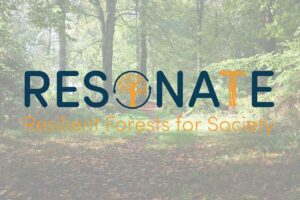Josh Roberts MICFor, Policy Advisor at Scottish Forestry, reports on Continuing Professional Development (CPD) for the Institute of Chartered Foresters.
I don’t think of the annual CPD obligation as a target to reach to stay in the Institute’s good books. And I reckon, deep down, that’s not how the Institute sees it either.
My Continuing Professional Development is exactly that: my professional development – for me, about me and by me. And the only part that feels like an obligation is recording it, which the online portal makes very easy. For me, the bottleneck in keeping my records updated occurs because of confusion over what counts as CPD and then in sitting down to record what I’ve done.
The Official Guidance
The language of the guidance makes the CPD obligation sound a lot more daunting than it is:
review your existing personal and professional experience. In particular, you should analyse where your skills or knowledge may be lacking and define areas for improvement.
Making a wish list of what I’d like to achieve is useful but this instruction seems to set a high bar that used to prevent me from recognising and valuing legitimate learning activities that didn’t seem to fit the brief.
Continuing Professional Development (CPD) is the structured maintenance and broadening of knowledge and skills and the development of personal qualities that are necessary for the execution of professional and technical duties throughout a member’s working life.
Structured is not the Same as Formal
That word ‘structured’ initially led me to narrow my view of CPD to include only formal training courses and I often went even further and questioned whether formal training counted if work wanted me to do it. If I had to do it for work, how could I count it as CPD?
It is easy to interpret the guidance and constrict your idea of what activities are CPD enough. But structured learning isn’t the same as formal learning, which is only one of a wide range of activities that qualify as CPD.
I ended up recording less and less, either because things seemed too closely aligned with my job to call them CPD or because they didn’t seem formal enough to count. Recognising that ‘structured’ actually means that I’ve structured my CPD around the knowledge and skills that I have to maintain and develop allowed me to break this cycle and recognise all of the valuable CPD I was actually doing.
So what counts and what doesn’t?
Here’s some guidance from Ben, Member Services Manager at the Institute:

CPD is the ongoing learning we all do to keep our knowledge and skills relevant for our jobs so we can perform to our best ability and meet the inevitable challenges in our changing sector. It should also help develop skills and prepare for what might come next.
It’s probably easier to eliminate what doesn’t count and go from there.
If your job depends on your ability to use a particular machine or programme, or on your understanding of a particular issue or piece of legislation or policy, the learning you need to do to get there shouldn’t count as Continuous Professional Development; it’s just what you need to know to do your job.
CPD then, is what keeps you up to date with the latest developments and thinking in your field; it allows you to innovate or look at your work in new ways. So, although the original learning shouldn’t count, keeping up with new developments does. CPD should broaden and enrich your thinking and professional practice – it’s what you do to keep from being left behind!
So my first step was to worry less about whether something was quite “CPD enough”. If it helps me maintain or develop skills and knowledge that are useful for me as a professional forester, it counts. (I’ve provided some examples of activities which I found incredibly useful below, which might inspire you.)
The next step was to start looking back and making notes about what I’ve been up to recently that’s helped me learn and improve. We’re driven all the time to move onto the next problem, but with just ten minutes every month or so to look back, I find I can easily make at least a few notes about particular things that have helped me develop.
Keeping the habit of recording is the hardest part so I don’t write detailed descriptions to start with, just notes to come back to later. Then maybe twice a year I type them up fully.
So I suppose that’s my key message here: start writing it down. If you did something, read something, or went somewhere and learned something that broadened your knowledge or skills for your professional life, write it down! It’s your journey. It’s what you learned. So record it and explain why it was important. Once you start, you’ll probably find you’ve done a lot more than you realise.
Examples of things I have recorded as CPD that you might have done and overlooked or might like to try:
- Voluntary work in local woodlands.
I learned so much from my involvement in my local woodland management group. It operated at a completely different scale to some of the other forestry I was used to dealing with, which meant I got involved in activities that I knew about but was normally very distant from in my day job. So often these small local groups are only held together by a few individuals, so we discount any time we give them as being too ‘unstructured’. This is a mistake! The learning and development I got from the hours I put in was far too valuable to omit for fears over its unstructured nature.
- Reading popular books
Have you read James Rebanks’ ‘The Shepherd’s Life’? How about George Monbiot’s ‘Feral’ or Isabella Tree’s ‘Wilding’? Did they influence or inform your opinions about the impact, relevance and direction of our industry within a society that is changing the way it thinks about the environment and rural land management? Just because you’re not reading ‘Managing Native Broadleaved Woodlands’ on the train between meetings doesn’t mean you can’t value the impact of reading ‘popular’ books about trees, forests and land management.
Keeping in touch with how wider society views the role of forests within the environment and rural economy is often something our industry talks about trying to do better. So get better at it but start easy, and value it when you make the effort. Just be realistic about how relevant the reading actually is to your development – it might take you six hours to read the book but you probably only want to record a couple of hours as CPD.
- Work shadowing
This is something we often talk about and it gets nods of general support by managers and in boardrooms, but very few people ever try to arrange it. I would really encourage you to try and it’s usually much easier to arrange than you’d think – if you can be patient and flexible and brave enough to make contact! The other misconception about shadowing that puts people off, particularly if you’re working in a smaller business, is that you have to lose a whole day to do it. A couple of hours with someone new, seeing what their work involves and how they need to do it can be really enlightening. But sometimes even more beneficial than learning about the job is learning about the person/team/organisation you’re shadowing. Try it.






